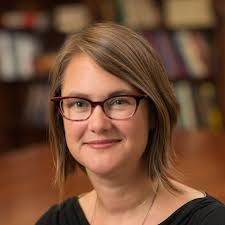The open-access publication of Furnace and Fugue: A Digital Edition of Michael Maier’s “Atalanta fugiens” (1618) with Scholarly Commentary by Brown University faculty member Tara Nummedal and independent scholar Donna Bilak is a landmark for Brown University’s Digital Publications Initiative funded by the Andrew W. Mellon Foundation. Tara Nummedal also recently taught a collaborative humanities graduate seminar on premodern art-science with History colleague Harold Cook and in partnership with faculty at the University of Minnesota.
Furnace and Fugue: A Q&A with Tara Nummedal

What made collaboration particularly valuable for the digital publication of this 17th-century text?
Furnace and Fugue is a study and edition of a 1618 printed book, Atalanta fugiens, which rereads the Classical myth of Atalanta as an alchemical recipe for making the philosophers’ stone. The book is a collection of fifty emblems, each of which contains multiple parts: a motto and epigram in German and Latin, a copperplate etching, the score of a fugue for three voices, and a Latin discourse that expands on the emblem’s themes.
Earlier studies of Atalanta fugiens focused on a single element of the book: the music, for example, or the discourses. We wanted to examine Atalanta fugiens as a multimedia artifact, as a book that depends on the synergies among its parts. We quickly realized, however, that if in 1618 Maier could reasonably expect a single reader to have the wide-ranging erudition and skill-set to engage his book — that is, knowledge of not only Latin, German, and music, but also an understanding of mathematics, poetry, alchemy, art, astronomy, and music — modern disciplinary boundaries have fractured our expertise. In short, we could only make sense of Atalanta fugiens through a multidisciplinary collaboration. And so Furnace and Fugue emerged out of a series of workshops and conversations among scholars of early modern print, music, art, philosophy, mathematics, and alchemy, as well as rare book curators and singers, where we shared our specific expertise and sought out connections between the parts of Atalanta fugiens that we would have missed otherwise. Once we started creating Furnace and Fugue, of course, we embarked on another kind of collaboration, working also with technologists, graphic designers, and digital humanists.
Credits for the project extend to digital editing, design, text and music transcription, singers, audio recording, photography, and videography. To what extent did these layers of collaboration inform your conception of the project and its final outcome?
Donna Bilak and I knew from the outset that we wanted Furnace and Fugue to be interdisciplinary and also to include music recordings. The final form of the book, however, absolutely depended on the ideas, experience, and expertise of the programmers, designers, and digital humanists who worked with us on the project. Elli Mylonas’s long experience with text encoding was crucial to the evolution of the edition, for example, as was the recording and performance experience of our contributor Loren Ludwig, who helped us realize the music. The collections feature, which allows readers to assemble their own collections of emblems from Atalanta fugiens, came out of conversations with designers Crystal Brusch and Studio Rainwater as a way to better integrate the two parts of the project — the edition and the scholarly essays. Meanwhile, Digital Scholarship Editor Allison Levy brought her own editorial experience to the project and helped keep all of the moving parts on track. The “authorship” of Furnace and Fugue, in other words, mirrors that of the original 1618 book. It took many people to create Atalanta fugiens, from its named author Michael Maier, to the printers, funders, and artisans who produced books for the publishing firm, to the unacknowledged sources of Maier’s ideas, images, and music. Although Donna Bilak and I appear as coeditors, Furnace and Fugue required just as many (if not more!) hands and minds to bring it to fruition.
Drawing from this experience, what would you say to someone interested in embarking on a collaborative research project?
Buckle up! Once we really got Furnace and Fugue underway, it quickly developed its own momentum and swept us all in. It was exciting, but so different from the way I wrote my other books (which is to say, alone, in archives, and at my computer, and at my own pace). With Furnace and Fugue, each of the parts depended on the others, so we all had to work at a collective pace in order to coordinate these parts. I would also say that a collaborative research project requires extraordinary openness, curiosity, and flexibility. I had to learn to rethink my own vision again and again, both in response to technical challenges or opportunities, and also to incorporate the ideas and priorities of my co-editor Donna Bilak and the other contributors.
What were the biggest challenges along the way and what did you learn from them?
Collaboration is rewarding, but it is also difficult. It can be challenging to understand and even appreciate other scholars’ disciplines, expertise, and perspectives. I learned that practice can help bridge that gap, as can exploring the same object (in this case, Atalanta fugiens) together. But beyond this, I would say that co-creating a piece of scholarship also requires giving up a bit of ego, as well as our conventional idea of “authorship.” Outside of the individual essays that Donna Bilak and I each contributed to Furnace and Fugue, much of the book was created collaboratively, and it is difficult now to disentangle who contributed what. This can make the book somewhat illegible in a profession that still prizes individual authorship. Many of us involved in the project were in a position to take this risk, but I am not sure it’s for everyone, especially those on a conventional tenure path — at least not yet.
Furnace and Fugue
Furnace and Fugue: A Digital Edition of Michael Maier’s “Atalanta fugiens” (1618) with Scholarly Commentary is published by the University of Virginia Press and includes texts, images, musical transcriptions, and audio recordings.